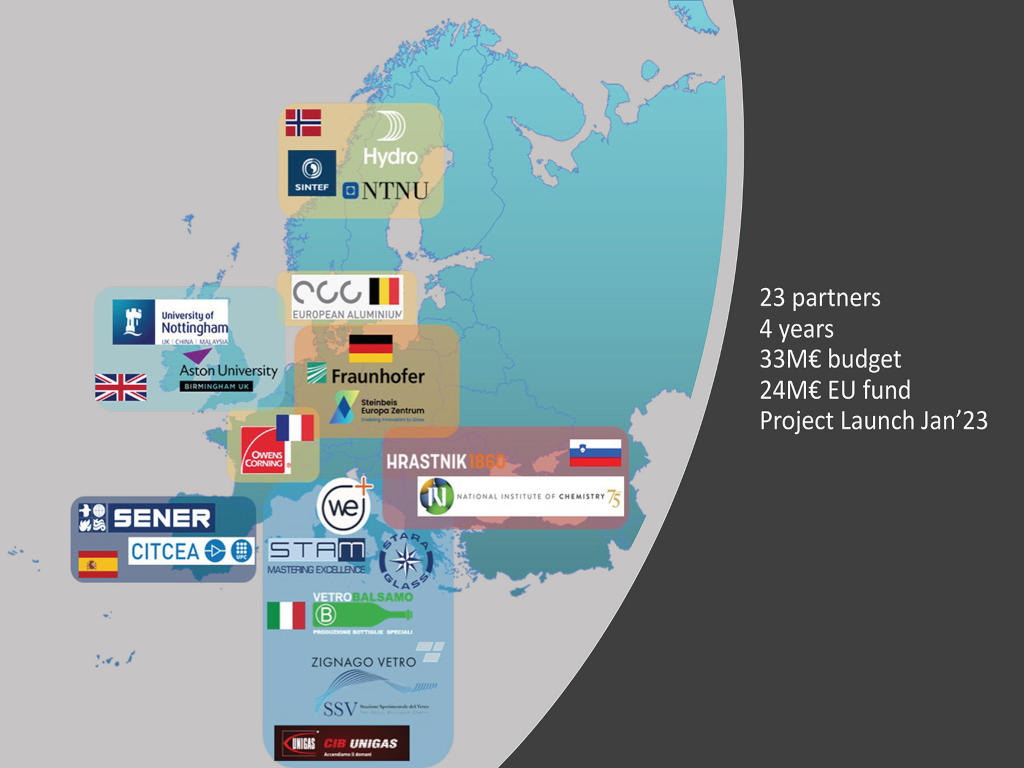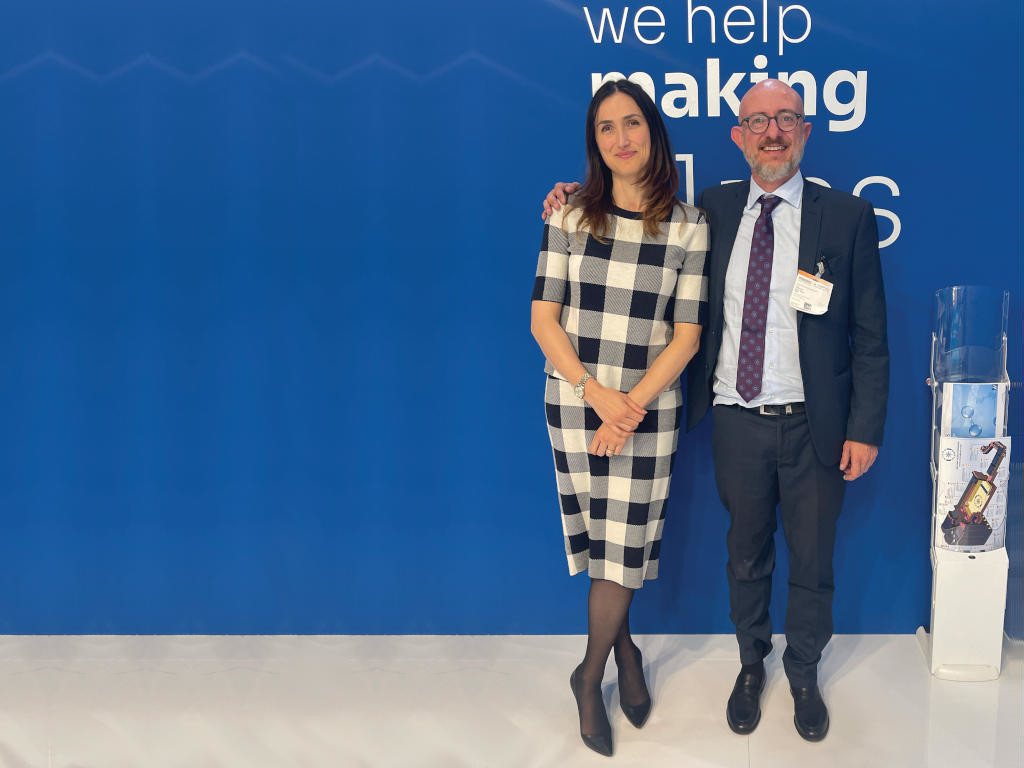Despite working together for the best part of a year, Ernesto Cattaneo and Chiara Caccamo didn’t actually meet in person whilst preparing their proposal for Horizon Europe’s call for proposals regarding replacement of fossil fuels with hydrogen. The experts from Stara Glass and SINTEF, based in Italy and Norway, respectively, were finally able to convene in Germany at glasstec 2022 where they discussed the success of their long-distance collaboration, which resulted in a €24 million grant from the European Union to study full hydrogen combustion in the glass industry and to push automation and control at higher levels.
“The glass industry nowadays has come to a point in which it will take some direction to sort the issues with carbon emissions and the solutions that have been already widely identified: electrification, carbon capture and hydrogen,” explains regular Glass Worldwide contributor and Head of Innovation Projects at furnace specialist Stara Glass, Ernesto Cattaneo. “We answered Horizon’s call about hydrogen.”
Horizon Europe is the European Union’s key funding programme for research and innovation. The EU budget supports the large-scale deployment of renewable and low-carbon hydrogen to meet the continent-wide target of 55% reduction of greenhouse gas emissions by 2030 compared to 1990 levels, and climate neutrality by 2050. Funding is intended to provide support to researchers and innovators to drive systemic changes to ensure a ‘green, healthy and resilient EU’.1
Horizon Europe H2GLASS
“We, as Stara Glass, are of course doing all of that [decarbonising] action because we are glass furnace designers,” says Mr Cattaneo. For instance, Stara’s Centauro furnace utilises thermal power/recovered heat, while the company is a partner in the ongoing LIFE SUGAR project, co-funded by the European Union’s Life Programme, which focuses on using heat recovered from furnace waste gases to power a steam-methane reforming (SMR) reaction for producing hydrogen and energy-dense syngas.
“We became involved in the Horizon project [due to] SINTEF (Norway’s research centre) presented by Chiara Caccamo who acts as the Project Co-ordinator,” continues Mr Cattaneo. “The glass industry is a super energy-demanding field and SINTEF realised that hydrogen could be applied to solve the carbon issue.”
SINTEF is proficient in managing large research projects, in co-operation with international participants through EU grants. Putting together the proposal for the Horizon project, Ms Caccamo was conscious that, compared to other energy-intensive sectors suitable for H2 utilisation, e.g. iron/steel and chemicals, “the glass industry and the aluminium industry were the ones lagging behind” in terms of funding for projects addressing the replacement of fossil fuels with H2. “There’s a need for the glass industry to receive funds to be able to innovate,” she insists.
“Also, you must recognise that there are no real alternatives to glass,” interjects Mr Cattaneo. “Glass is really energy-demanding: glass is produced at more than 1,400°C. But it’s either glass or plastic… and we know what it means, that it must be glass!"
“Once, emissions were not a problem,” he continues. “If you look at the priorities of glass production until the 50s, the 60s, the only issue was to have a good quality. After that, they realised they should lower the consumption; then, 15–20 years ago they realised that nitrous oxides (NOx) were a problem and so we had to go in that direction and find solutions to that issue. Now, the problem is simple: the glass industry is producing 5% of European carbon dioxide emissions. It’s millions of tons… We have to do something and we have to do it soon.”
Successful application
Through SINTEF, Ms Caccamo was able to organise a cluster of 23 companies who committed to a proposal for a project to decarbonise the glass industry using hydrogen for combustion (which produces water as a by-product) instead of furnaces running on fossil fuels. They applied to Horizon for project funding, with a total budget estimated at €33 million.
“The success rate of a Horizon application is only a little superior to zero,” says Mr Cattaneo drily, recalling the nail-biting process they endured. “There is a lot of competition because the different projects are financed in different ways. Horizon is one of the better-financed projects. Non-profit companies like universities and research centres are 100% financed. You can imagine the volume of competition we are talking about with this volume of money. It’s crucial to be perfect in the application.”
Final project sign-off was down to Ms Caccamo, who notes that, “It’s a lot of prestige because you compete at the European level so it’s also important to factor in the right partners – you build a ‘family’ during the proposal phase: the level of interaction and the combination of partners and the transparency are critical.”
“Writing the application is very intense work,” agrees Mr Cattaneo. “It’s very co-operative work and if you have 23 companies, it’s really challenging. At the end – the last few days, when you are expecting the results, we became kind of best friends – we were exchanging messages: ‘When do they announce…?!’”
So when did they receive the news about their proposal?
The momentous occasion is etched in Ms Caccamo’s memory: “30th July 2022,” she answers with a smile. “Around one o’clock.”
“I remember it very well!” adds Mr Cattaneo. “I was going out to a restaurant and she calls me – she’s in Norway so normally we text – I saw her name on the phone ringing and I started screaming! In fact I had an unforeseen round of grappa after lunch,” he laughs.
The European Union awarded €24 million funding to H2GLASS at the end of July 2022 and has started the Grant Agreement process. Innovations generated by H2GLASS reportedly have the potential to create 10,000 new jobs and unlock €1–5 billion of revenue for glass technology deployment, as well as generating investments of upwards of €17 billion and 200,000 new jobs for green H2 – all this while cutting emissions by about 80%.2 The start date for the project is January 2023.
“So now we are finalising the Grant Agreement, which is the contract with the European community,” explains Ms Caccamo. “We are in the legal phase of the project and then after we sign off everything we can start work."
“We have a timescale of four years,” she continues. “We plan to start the first experiments in two years from the start, around 2025.”
How viable is hydrogen?
There is huge scope for hydrogen – the most abundant element in our known universe – to play a key role in future energy systems as the EU moves away from its dependency on fossil fuel. “Unfortunately, you cannot find pure hydrogen, on earth, you must produce it somewhere,” notes Mr Cattaneo.
Fossil-based ‘grey’ hydrogen sourced from natural gas is the most common type used at present. Also made from natural gas, low carbon ‘blue’ hydrogen is a cleaner option because CO2 emitted during its production is captured and stored underground. Hydrogen for H2GLASS will be created through a ‘portable’ electrolyser; this hydrogen production method is almost emission-free and its only by-product is water.3
There are “a lot of viable solutions” for hydrogen to replace fossil fuels in the glass melting process, believes Ms Caccamo. However, “there are many factors to be considered for success – it depends on the factory; it depends on policies, how they will consent industry to adopt hydrogen depends a lot on the cost of the installations, the availability of the infrastructures (gas grid) … there are a lot of parameters,” she cautions. “We just say that with Horizon, it will be a joint effort.”
“We can take care of the technical viability,” she continues. “We can sort the industrialisation part, but then when it comes to costs we will need also the support of policy makers and governments… Because as of now hydrogen is expensive, we know that, and we also need a lot of investment in renewables in order to produce the quantity of hydrogen that is required.”



